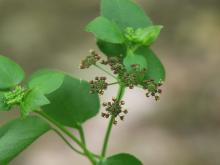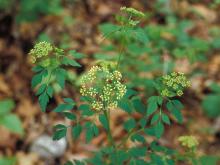Wildflowers, Grasses and Other Nonwoody Plants
Media

Species Types
Scientific Name
Panax quinquefolius
Description
Wild and cultivated ginseng produce an annual crop in the United States and Canada valued in excess of $25 million, but overzealous collection is causing serious concern about the survival of American ginseng in the forest ecosystem.
Media

Species Types
Scientific Name
Oxalis violacea
Description
Missouri has one introduced and four native wood sorrels. Violet wood sorrel is the only one that has magenta or lavender flowers.
Media

Species Types
Scientific Name
Ranunculus hispidus
Description
Hispid buttercup is a densely hairy plant with showy yellow flowers. It is found mostly in the southern half of Missouri, usually in moist locations.
Media

Species Types
Scientific Name
Fragaria virginiana
Description
Wild strawberry is one of the parents of the cultivated strawberry and is one of our prized native wild edibles. It’s also a valuable food for innumerable animals, and it’s attractive in native wildflower gardens.
Media

Species Types
Scientific Name
Potentilla simplex
Description
Common cinquefoil, or five-finger, is named for its leaves, which are divided into five fingerlike leaflets. One of seven cinquefoils in Missouri, it blooms from April to June and is scattered nearly statewide.
Media

Species Types
Scientific Name
Ranunculus fascicularis
Description
There are nearly 20 species in the genus Ranunculus in Missouri. Identify early buttercup by its early blooming time, its distinctively shaped, usually hairy leaves, and its preference for open woods, glades, or prairies.
Media

Species Types
Scientific Name
Ranunculus harveyi
Description
A slender little buttercup growing in rocky, dry areas with acidic soils, Harvey’s buttercup occurs mostly in southern Missouri. One key to identify it is to examine the basal and stem leaves, which are quite different.
Media

Species Types
Scientific Name
Polytaenia nuttallii
Description
Found mainly in the southern half of the state, in prairies and glades, prairie parsley is an upright, stout-stemmed perennial with small yellow flowers in umbrella-shaped clusters. It blooms April through June.
Media

Species Types
Scientific Name
Thaspium trifoliatum
Description
One of our more challenging plants to identify, meadow parsnip looks an awful lot like golden Alexanders. But you can do it! Look closely at the flower clusters and at the edges of the leaves, and then check the seeds.
Media

Species Types
Scientific Name
Zizia aurea
Description
Named for its resemblance to a European herb that was popular in Medieval times, golden Alexanders is a native Missouri wildflower with bright yellow flowers arranged in umbrella-like clusters.
See Also
About Wildflowers, Grasses and Other Nonwoody Plants in Missouri
A very simple way of thinking about the green world is to divide the vascular plants into two groups: woody and nonwoody (or herbaceous). But this is an artificial division; many plant families include some species that are woody and some that are not. The diversity of nonwoody vascular plants is staggering! Think of all the ferns, grasses, sedges, lilies, peas, sunflowers, nightshades, milkweeds, mustards, mints, and mallows — weeds and wildflowers — and many more!





















